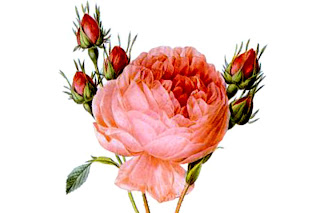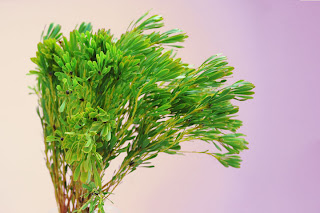
 One of my favorite things to do when I go back to Britain is to visit the second-hand book shops. In actual fact most ot the bookshops are selling books of some value, although clearly one man's treasure is another man's trash. In Edinburgh there are several bookshops in which I always like to spend time perusing their flower and garden sections for old and/or illustrated books. I delight in these books, and find that the older volumes devoted to flowers give me an insight into just how much of a fashion based business it is that we are in, as it is easy to see that what was once old and forgotten will come around again, as it has so many times before. For instance consider this observation from a charming book I picked up called "The Scented Garden" by Eleanour Sinclair Rohde:
One of my favorite things to do when I go back to Britain is to visit the second-hand book shops. In actual fact most ot the bookshops are selling books of some value, although clearly one man's treasure is another man's trash. In Edinburgh there are several bookshops in which I always like to spend time perusing their flower and garden sections for old and/or illustrated books. I delight in these books, and find that the older volumes devoted to flowers give me an insight into just how much of a fashion based business it is that we are in, as it is easy to see that what was once old and forgotten will come around again, as it has so many times before. For instance consider this observation from a charming book I picked up called "The Scented Garden" by Eleanour Sinclair Rohde: 
 "On the show table, however, modern roses reign supreme. Those serried ranks of hybrid teas give one the impression that not only are they at home at a show, but that the enjoy it. I am always struck with the fact that their colors are so curiously like the more expensive materials displayed in shop windows. And the leaves (and even the thorns) of many of the modern varieties look as though they had been rationed. There is always just enough and not a leaf nor a thorn to spare. What a contrast to the abundant healthy foliage (and the thorns!) of the old roses. No, those of us who love the old roses are not blind, nor do we suffer from the hallucination that modern roses are scentless. We see quite clearly that they are beautful, but somehow their beauty fails to touch our hearts." That was written in 1931!! I imagine garden roses and the desire for sweet perfumes and the old cabbage shape in floristry have come and gone a few times since then. Of late however, especially with the introduction of the David Austin cutting roses and varieties from Meilland such as Yves Piaget and Prince Jardinier, it seems that we are returning to the forms and scents described in the passage, but now featuring vase life that is more consistent with modern expectations. Indeed, the rose breeders are striving to reintroduce sweet perfumes and low centered, fully quartered rosette shapes to their catalogues.
"On the show table, however, modern roses reign supreme. Those serried ranks of hybrid teas give one the impression that not only are they at home at a show, but that the enjoy it. I am always struck with the fact that their colors are so curiously like the more expensive materials displayed in shop windows. And the leaves (and even the thorns) of many of the modern varieties look as though they had been rationed. There is always just enough and not a leaf nor a thorn to spare. What a contrast to the abundant healthy foliage (and the thorns!) of the old roses. No, those of us who love the old roses are not blind, nor do we suffer from the hallucination that modern roses are scentless. We see quite clearly that they are beautful, but somehow their beauty fails to touch our hearts." That was written in 1931!! I imagine garden roses and the desire for sweet perfumes and the old cabbage shape in floristry have come and gone a few times since then. Of late however, especially with the introduction of the David Austin cutting roses and varieties from Meilland such as Yves Piaget and Prince Jardinier, it seems that we are returning to the forms and scents described in the passage, but now featuring vase life that is more consistent with modern expectations. Indeed, the rose breeders are striving to reintroduce sweet perfumes and low centered, fully quartered rosette shapes to their catalogues. However, one passage in this lovely little tome was a chapter devoted to aromatic herbs, that features a recipe entitled "To enable one to see fairies".
However, one passage in this lovely little tome was a chapter devoted to aromatic herbs, that features a recipe entitled "To enable one to see fairies"."To enable one to see fairies. A pint of sallet oyle and put it into a vial glasse: and first wash it with rose-water and marigolde water; the flowers to be gathered towards the east. Wash it till the oyle becomes white, then put into the glasse, and then put thereto the budds of hollyhocke, the flowers of marygolde, the flowers of tops of wilde thyme, the budds of young hazel, and the thyme must be gathered near the side of a hill where fairies used to be; and take the grasses of a fairy throne, then all these put into the oyle in the glasse and sette it to dissolve three dayes in the sun, and then keep it for thy use."
How absolutely delightful! However, I do have a question: How does one find a fairy throne?
Images top to bottom:
1. Patience by David Austin
2. Rosa centifolia; painted by Redoute 19th century
3. Yves Piaget by Meilland
4. Miranda by David Austin
5. Figure adorning a tomb; Greyfriars Kirkyard, Edinburgh
Images top to bottom:
1. Patience by David Austin
2. Rosa centifolia; painted by Redoute 19th century
3. Yves Piaget by Meilland
4. Miranda by David Austin
5. Figure adorning a tomb; Greyfriars Kirkyard, Edinburgh






























